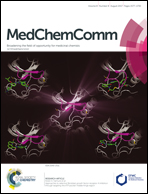Developments of bioorthogonal handle-containing photo-crosslinkers for photoaffinity labeling
Abstract
Photoaffinity labeling (PAL) has been widely applied in various research areas such as medicinal chemistry, chemical biology and structural biology, owing to its capability of investigating non-covalent ligand–protein interactions under native environments and elucidating protein structures, functions etc. One important application of this technique is to use affinity-based proteome profiling (AfBP) coupled with bioimaging for profiling drug–target interactions in situ. In order to accurately report drug–target interactions via these approaches, several considerations as follows need to be made: (1) maximally retaining bioactivities of photoprobes upon functionalization with a photoreactive group and a reporter tag from a parental compound; (2) performing proteome profiling and imaging in situ simultaneously, to monitor drug–target interactions in different manners; and (3) developing excellent photo-crosslinkers capable of photo-crosslinking and fluorescence turn-on at the same time. With these considerations in mind, we have developed three versions of “minimalist” bioorthogonal handle-containing photo-crosslinkers (L3–L6) during the years and successfully applied them in all kinds of small bioactive molecules for protein labeling and cellular imaging studies. In this mini-review, the features and functions of these linkers are specifically highlighted and summarized.



 Please wait while we load your content...
Please wait while we load your content...